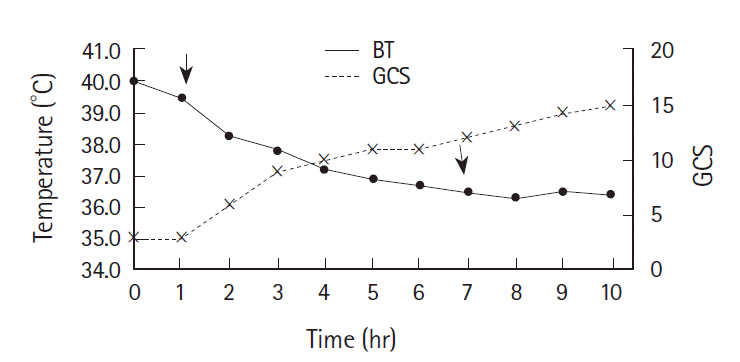INTRODUCTION
Heat stroke is diagnosed according to clinical features. It is a life-threatening condition requiring emergency treatment and is associated with a high mortality rate. Heat stroke is accompanied by an elevated body temperature (>40°C) and an alteration of consciousness [1]. It mainly occurs when excessive heat is absorbed from outside the body.
CASE REPORT
A 67-year-old healthy woman was transported to the emergency department by the emergency medical services. She was found unconscious in a sauna 1 hour before she arrived at the emergency department. Her Glasgow Coma Scale (GCS) was 3, and her rectal temperature was 40.5°C. The patient’s blood pressure was 120/80 mmHg; pulse was 96 beats/min; and respiratory rate was 28 breaths/min. There were second-degree burns on the right arm, trunk, and leg, from which we could infer that she was in the right decubitus position. Total burn area of body surfaces was 18%. She was unconscious, but she breathed spontaneously with good oxygen saturation. Therefore, we decided to treat the patient without intubation and sedation. She had slightly increased liver function tests: aspartate transaminase and alanine transaminase were 68 IU/L and 39 IU/L, respectively (normal range, 10 to 36 IU/L). Creatinine was normal at 0.94 mg/dL (normal range, 0.5 to 1.1 mg/dL). Initial arterial blood gas analysis with 5 L oxygen via nasal prong revealed PaO2, 188 mmHg; PaCO2, 34 mmHg; SpO2, 100%; pH, 7.40; and base excess, -3.7 mmol/L.
Upon arriving at the emergency department, intravenous cold saline infusion and burn treatment were initiated. Brain magnetic resonance imaging was performed to exclude a cerebrovascular event. Meanwhile, the patient’s body temperature dropped to 39.5°C, but her level of consciousness remained at the GCS score of 3. In order to accelerate cooling, an external-cooling device (Arctic Sun Temperature Management System, Medivance, Louisville, CO, USA) was applied. A total 2.3 L of Hartman solution and normal saline was administered for an 8-hour period. External cooling was started 1 hour after entering the hospital, and her body temperature dropped to 38.3°C 1 hour after the external-cooling (Fig. 1. Two hours after arrival). A frowning reaction in response to stimuli (GCS score, 6) also occurred at this time point. Three hours after arrival (2 hours after the external-cooling), her body temperature dropped to 37.8°C (Fig. 1), and she became responsive to stimuli and showed a pain avoidance reaction (GCS score, 9). At 7 hours, her body temperature dropped to 36.5°C, and she began to open her eyes spontaneously (GCS score, 12). Since the patient’s neurological response was in rapid recovery, we stopped the cooling and maintained her body temperature at 36.5°C for an additional 12 hours. The patient became alert when the device was removed. She was admitted to an intensive care unit, and moved to a general ward after one day. At 18 days after hospital admission, she was discharged without any neurological complications.
DISCUSSION
Even if the ambient temperature changes, the human body tries to maintain a constant body temperature through autonomous function. However, continuous extreme heat from the outside, or excessive physical activity in a sufficiently hot environment, may lead to various heat associated disease. Heat stroke is a potentially life-threatening disease, and an effective drug treatment for heat stroke has not been established. If serious, death due to multiple organ dysfunction, such as brain edema and abnormal liver function, may occur. It is known that a worse prognosis is often associated with long-term exposure at a slightly lower temperature than a short-term exposure at a high temperature. Heat stroke occurs frequently during physical labor or exercise in a hot and humid environment. In this case, the patient apparently lost body temperature control while lying in a sauna.
Traditional heat stroke treatments include external-cooling methods (e.g., cold-water immersion and evaporative cooling) and internal-cooling methods (e.g., lavaging stomach, bladder, and rectum with cold water, or intravenous injection of cold saline). These treatments should be stopped when the body temperature reaches around 39°C because it is difficult to precisely target the desired body temperature with these methods. Recently, various devices for temperature management have been introduced as options for postresuscitation care. One of these devices, the Arctic Sun Temperature Management System is an external-cooling device. These devices are expected to be used for temperature management, such as fever control, because they can effectively target a desired body temperature. There has been limited reports of the device’s use for treatment of heat stroke.
The report by Hong et al. [4] is the first case in which an external-cooling device was used to successfully treat heat stroke. Subsequently, Lee et al. [5] reported similar findings. In both of these instances, the body temperatures of treated patients were lowered to 33°C using a modified postresuscitation TH protocol followed by waking of the patients. However, in the case reported here, we applied the device to a spontaneously breathing patient, while observing neurological improvement without intubation and sedation. In addition, we focused on body temperature control (target temperature set at 36.5°C) rather than hypothermic temperature treatment. Our patient quickly regained consciousness and showed good neurologic outcome and body temperature control.
In regards to heat stroke in animals, studies have shown that moderate hypothermia after heat stroke inhibited excessive generation of superoxide anion radical and inflammatory reactions in blood and liver; suppressed acute lung inflammation and injury; and reduced multiorgan dysfunction [6-8].
In conclusion, rapid cooling using an external-cooling device appears to be an easier and more effective method for controlling the body temperature of heat stroke patients than other external cooling methods, such as cold-water immersion. The latter is difficult to conduct in the usual emergency department. Furthermore, compared with traditional internal-cooling methods, body temperature can be controlled to the desired temperature with a lower likelihood of neurologic complications using the present method. Additional studies will be needed to confirm these observations.














